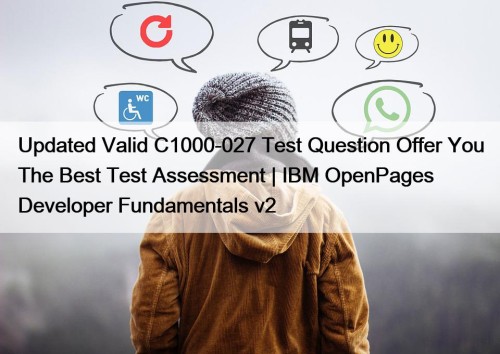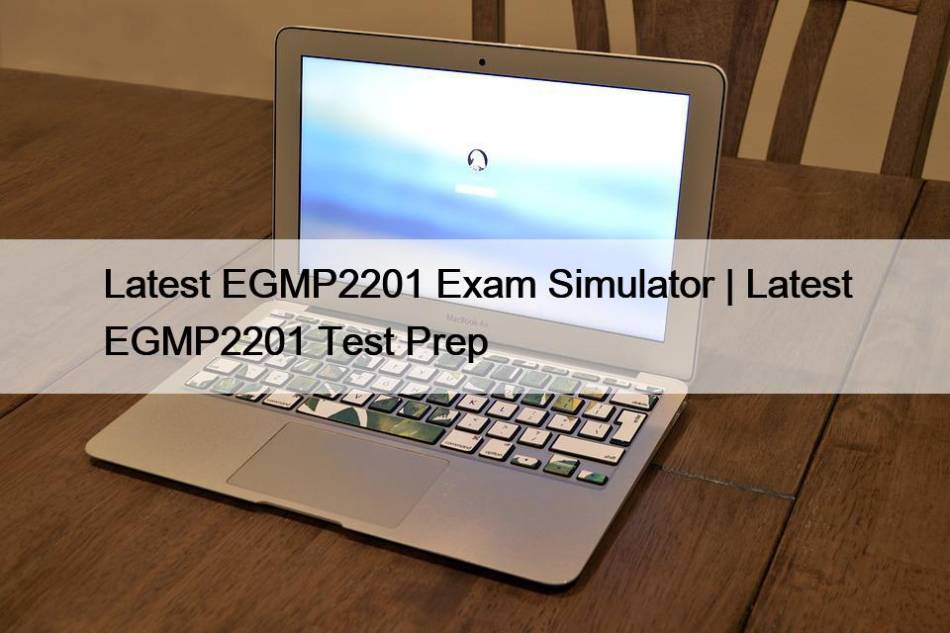Most Popular
 Updated Valid C1000-027 Test Question Offer You The Best Test Assessment | IBM OpenPages Developer Fundamentals v2
Updated Valid C1000-027 Test Question Offer You The Best Test Assessment | IBM OpenPages Developer Fundamentals v2
BONUS!!! Download part of TorrentExam C1000-027 dumps for free: https://drive.google.com/open?id=1beRLSzw42iFGC3VnQ3UcWPgCAzFAHO8kIf ...
 Latest 250-580 Exam Practice - 250-580 Test Simulator Online
Latest 250-580 Exam Practice - 250-580 Test Simulator Online
As long as you face problems with the 250-580 exam, ...
 Pass Guaranteed Quiz 2025 1z0-1041-22: Useful Oracle Cloud Platform Enterprise Analytics 2022 Professional Reliable Study Questions
Pass Guaranteed Quiz 2025 1z0-1041-22: Useful Oracle Cloud Platform Enterprise Analytics 2022 Professional Reliable Study Questions
BONUS!!! Download part of Pass4SureQuiz 1z0-1041-22 dumps for free: https://drive.google.com/open?id=1KGO40c6DHSfOCtJU91tBO7kL6DHpiyVNDue ...



Latest EGMP2201 Exam Simulator | Latest EGMP2201 Test Prep

If you are determined to get the certification, our EGMP2201 question torrent is willing to give you a hand; because the study materials from our company will be the best study tool for you to get the certification. Now I am going to introduce our EGMP2201 Exam Question to you in detail, please read our introduction carefully, we can make sure that you will benefit a lot from it. If you are interest in it, you can buy it right now.
The Esri EGMP2201 exam has been designed to test a wide range of skills, including data management, database design, data modeling, performance optimization, and security control. Successful completion of EGMP2201 exam will enable professionals to demonstrate their expertise in GIS data management and enhance their career prospects. In addition, the Esri EGMP2201 certification provides professionals with an opportunity to prove their mastery of key geodatabase management skills and techniques, which is highly valued by employers looking to hire GIS professionals.
Esri EGMP2201 Exam is a rigorous exam that requires candidates to have a strong understanding of Esri technologies and how they can be used to manage geospatial data. EGMP2201 exam consists of 90 multiple-choice questions and has a time limit of 2 hours and 30 minutes. To pass the exam, candidates must score at least 70%.
>> Latest EGMP2201 Exam Simulator <<
Latest EGMP2201 Test Prep & EGMP2201 Pdf Dumps
If you want to understand our EGMP2201 exam prep, you can download the demo from our web page. You do not need to spend money; because our EGMP2201 test questions provide you with the demo for free. You just need to download the demo of our EGMP2201 exam prep according to our guiding; you will get the demo for free easily before you purchase our products. By using the demo, we believe that you will have a deeply understanding of our EGMP2201 Test Torrent. We can make sure that you will like our products; because you will it can help you a lot.
Esri Enterprise Geodata Management Professional 2201 Sample Questions (Q38-Q43):
NEW QUESTION # 38
A GIS data administrator needs to implement an offline mobile editing workflow that will include feature classes that participate in a geometric network.
Which versioning model should the data administrator use?
- A. Traditional versioning without move edits to base
- B. Branch versioning
- C. Traditional versioning with move edits to base
Answer: A
Explanation:
Geometric networks are not supported inbranch versioningor workflows where edits are moved directly to the base table. Therefore,traditional versioning without move edits to baseis the only viable option for implementing an offline mobile editing workflow with feature classes that participate in a geometric network.
1. Why Use Traditional Versioning Without Move Edits to Base?
* Support for Geometric Networks:
* Geometric networks are only compatible with traditional versioning workflows. Branch versioning does not support geometric networks, and using the "move edits to base" option bypasses the versioning framework required for geometric networks.
* Offline Mobile Editing:
* Traditional versioning supports creating replicas that allow offline editing and subsequent synchronization. This workflow is critical for mobile editing scenarios.
2. Why Not Other Options?
* Branch Versioning:
* Branch versioning is designed for feature services and web-based workflows but does not support geometric networks.
* Traditional Versioning with Move Edits to Base:
* This option moves edits directly to the base table, which is incompatible with geometric networks and versioning workflows that require offline editing.
Steps to Configure Traditional Versioning Without Move Edits to Base:
* Register the feature classes and datasets (including geometric networks) with traditional versioning in ArcGIS Pro.
* Create a replica to support offline editing workflows.
* Synchronize edits back to the geodatabase after offline editing, reconcile, and post to integrate changes into the Default version.
References from Esri Documentation and Learning Resources:
* Traditional Versioning Overview
* Geometric Networks and Versioning
Conclusion:
Usingtraditional versioning without move edits to baseis the only method that supports offline mobile editing workflows while maintaining compatibility with geometric networks.
NEW QUESTION # 39
An organization has a web service that must always be available. This service reads data from a feature class in an enterprise geodatabase. The GIS administrator needs to update the schema of the feature class.
Which workflow should be used?
- A. Disable schema locking on the service
- B. Run the Alter Field geoprocessing tool
- C. Delete the spatial index
Answer: A
Explanation:
Scenario Overview:
* The organization has a web service thatmust always be available.
* The service reads data from afeature classin an enterprise geodatabase.
* The GIS administrator needs to update theschemaof the feature class.
Why Disable Schema Locking?
* By default, ArcGIS services enforceschema lockingto ensure data consistency while the service is active. This prevents any modifications to the feature class schema (e.g., adding fields, altering attributes) while the service is running.
* Disabling schema locking allows schema updates to occur without disrupting the service's availability.
(ArcGIS Documentation: Schema Locking)
Steps to Disable Schema Locking:
* Access the ArcGIS Server Manager.
* Locate the web service and open itsservice properties.
* In the advanced settings, disable theschema lockingoption.
* Perform the required schema updates (e.g., adding fields or modifying the feature class).
* Re-enable schema locking if necessary for normal operation.
Alternative Options:
* Option B: Run the Alter Field geoprocessing tool
* This tool modifies fields but cannot execute schema changes while schema locks are active.
* Option C: Delete the spatial index
* Deleting the spatial index is unrelated to schema changes and could degrade query performance.
Thus, the correct workflow is todisable schema locking on the serviceto allow schema changes without disrupting the web service.
NEW QUESTION # 40
A large government organization mandates that all departments establish an equivalent data presence in a standby data center.
Which technology should the GIS database administrator recommend?
- A. Database replication
- B. Disconnected synchronization
- C. Geodatabase replication
Answer: A
Explanation:
For a large government organization requiring an equivalent data presence in a standby data center,database replicationis the ideal solution.
1. What is Database Replication?
* Database replication involves duplicating data from a primary database to a secondary database in near real-time or on a scheduled basis.
* This ensures that both databases are synchronized and capable of serving data if one fails.
2. Why Database Replication Fits the Requirement
* Standby Data Center: Database replication provides a fully equivalent copy of the data in the secondary data center.
* High Availability and Disaster Recovery: If the primary database is unavailable, the standby database can immediately take over, ensuring business continuity.
3. Why Not Other Options?
* Geodatabase Replication:
* While it is designed for replicating geodatabase content, it is typically used for GIS-specific workflows, such as syncing field edits. It does not ensure equivalence for non-spatial components of the database.
* It is not ideal for large-scale, organization-wide replication needs.
* Disconnected Synchronization:
* This is used in offline editing workflows where devices sync their edits with a central database at a later time. It is not suitable for maintaining an equivalent standby database.
4. Types of Database Replication
* Asynchronous Replication: Updates are replicated at scheduled intervals, offering flexibility but with slight delays.
* Synchronous Replication: Updates occur in real-time, ensuring both databases are always identical.
Steps to Implement Database Replication:
* Configure the primary and standby databases in the organization's DBMS (e.g., SQL Server, PostgreSQL, Oracle).
* Use the DBMS's built-in replication tools (e.g., SQL Server's Always On, PostgreSQL's Streaming Replication).
* Set up monitoring to ensure the replication process is functioning correctly.
References from Esri Documentation and Learning Resources:
* Database Replication in DBMS
* Disaster Recovery with Database Replication
Conclusion:
Database replicationis the recommended technology to establish an equivalent data presence in a standby data center, ensuring high availability and disaster recovery.
NEW QUESTION # 41
A GIS data administrator needs to restrict access to some fields in a feature class from unauthorized users.
Which method should the data administrator use?
- A. Query layer
- B. Database view
- C. Layer file
Answer: B
Explanation:
To restrict access to specific fields in a feature class, the GIS data administrator should use adatabase view.
1. What is a Database View?
* Adatabase viewis a virtual table created by a SQL query. It displays data from one or more tables or feature classes, but only the specified fields and rows are accessible.
* Views allow the administrator to control the fields and records visible to users without altering the underlying data.
2. Why Use a Database View?
* Provides fine-grained control over data access by limiting which fields (or rows) are visible to specific users.
* Helps enforce data security policies in multi-user environments.
* Can be shared as a read-only layer or with restricted update permissions, depending on the use case.
3. Why Not Other Options?
* Layer File:
* A layer file (*.lyr) only defines how data is symbolized and displayed. It does not restrict field access at the database level. Unauthorized users can still access hidden fields through direct database connections.
* Query Layer:
* A query layer allows for custom SQL queries when displaying data in ArcGIS but is not a security measure. Users can modify or bypass the query to access all fields.
Steps to Create a Database View:
* Use SQL to define the view, specifying only the required fields:
CREATE VIEW restricted_view AS
SELECT field1, field2
FROM feature_class
WHERE <condition>;
* Grant permissions to the view for authorized users while restricting access to the base table.
* Publish the view in ArcGIS as a read-only layer if needed.
References from Esri Documentation and Learning Resources:
* Creating and Using Database Views
* Data Security in Enterprise Geodatabases
Conclusion:
Adatabase viewis the most effective method to restrict access to specific fields in a feature class, ensuring data security while providing flexibility in data sharing.
NEW QUESTION # 42
A GIS analyst needs to visualize a centralized folder of imagery with multiple images in ArcGIS Pro. The administrator needs to prepare for this imagery to be accessed across the organization within the enterprise geodatabase.
Which storage mechanism should be used?
- A. Raster dataset
- B. Raster catalog
- C. Mosaic dataset
Answer: C
Explanation:
Amosaic datasetis the most appropriate storage mechanism for visualizing and managing a centralized folder of imagery, especially when the imagery is to be accessed across an organization through an enterprise geodatabase.
1. What is a Mosaic Dataset?
* A mosaic dataset is a geodatabase structure optimized for managing and serving large collections of raster data, such as satellite imagery or aerial photographs.
* It provides dynamic mosaicking, rendering, and query capabilities.
2. Why Use a Mosaic Dataset?
* Centralized Management: A mosaic dataset can reference multiple images stored in a folder without duplicating the data, maintaining a centralized source of imagery.
* Scalability: It supports large collections of raster data and allows for efficient querying, rendering, and analysis.
* On-the-Fly Processing: Provides options to apply image processing and rendering rules without modifying the source data.
* Enterprise Access: Mosaic datasets stored in an enterprise geodatabase can be published as image services for access across the organization.
3. Why Not Other Options?
* Raster Dataset:
* This option is for storing a single image or raster layer in the geodatabase, not suitable for managing multiple images.
* Raster Catalog:
* Raster catalogs organize rasters but lack dynamic mosaicking, rendering, and query optimization capabilities. They are less efficient and are now considered outdated in favor of mosaic datasets.
Steps to Create and Use a Mosaic Dataset:
* OpenArcGIS Proand connect to the enterprise geodatabase.
* Create a new mosaic dataset using theCreate Mosaic Datasettool.
* Add rasters to the mosaic dataset using theAdd Rasters to Mosaic Datasettool, pointing to the centralized folder of imagery.
* Publish the mosaic dataset as an image service in ArcGIS Enterprise for organization-wide access.
References from Esri Documentation and Learning Resources:
* Mosaic Datasets Overview
* Managing Imagery with Mosaic Datasets
Conclusion:
Amosaic datasetprovides the best functionality for managing, visualizing, and sharing multiple images from a centralized folder within an enterprise geodatabase.
NEW QUESTION # 43
......
EGMP2201 exam cram is famous for instant access to download, and you can receive your download link and password within ten minutes, so that you can start your learning immediately. If you don’t receive the download link, you can contact us, and we will solve the problem for you as quickly as possible. In addition, EGMP2201 Exam Dumps contain both questions and answers, and they also cover most of knowledge points for the exam, and you can improve your professional knowledge as well as pass the exam.
Latest EGMP2201 Test Prep: https://www.free4torrent.com/EGMP2201-braindumps-torrent.html
- 2025 Esri EGMP2201 Useful Latest Exam Simulator 🥎 Search for ➥ EGMP2201 🡄 and download exam materials for free through ☀ www.prep4away.com ️☀️ 🥮EGMP2201 Latest Exam Answers
- Reliable EGMP2201 Test Duration ⛳ EGMP2201 Valid Test Voucher 👇 EGMP2201 Latest Exam Answers 🖐 Search for ☀ EGMP2201 ️☀️ on ➠ www.pdfvce.com 🠰 immediately to obtain a free download 🐔EGMP2201 Guide
- 100% Pass Quiz 2025 EGMP2201: Trustable Latest Enterprise Geodata Management Professional 2201 Exam Simulator 🏌 Search for “ EGMP2201 ” and download it for free immediately on ➤ www.vceengine.com ⮘ 👼EGMP2201 Test Duration
- Pass4sure EGMP2201 Study Materials 🍹 EGMP2201 Guide 🥓 Reliable EGMP2201 Test Duration 🌃 Copy URL ▛ www.pdfvce.com ▟ open and search for ➽ EGMP2201 🢪 to download for free 🐣EGMP2201 Latest Exam Answers
- EGMP2201 Valid Test Pattern 🍛 Reliable EGMP2201 Exam Voucher 🍹 Pass4sure EGMP2201 Study Materials ☮ Immediately open { www.testsimulate.com } and search for ▷ EGMP2201 ◁ to obtain a free download 🎭EGMP2201 Training Questions
- EGMP2201 Updated Testkings 🚓 Reliable EGMP2201 Test Duration 🧦 EGMP2201 Valid Test Pattern 🔷 Easily obtain free download of ▛ EGMP2201 ▟ by searching on 《 www.pdfvce.com 》 🤪EGMP2201 Latest Exam Answers
- EGMP2201 Valid Test Pattern 👌 EGMP2201 Updated Testkings 🌔 EGMP2201 Guide 🤯 Search for 「 EGMP2201 」 and obtain a free download on [ www.prep4sures.top ] 🥝EGMP2201 Updated Testkings
- Reliable EGMP2201 Exam Voucher 🩲 EGMP2201 Latest Exam Answers 🧷 EGMP2201 Valid Test Pattern ⚗ Go to website ☀ www.pdfvce.com ️☀️ open and search for ⮆ EGMP2201 ⮄ to download for free 🕸EGMP2201 Reliable Exam Registration
- EGMP2201 Reliable Exam Registration 🧜 EGMP2201 Valid Test Voucher 🍢 EGMP2201 Updated Testkings 🚪 Search for ➽ EGMP2201 🢪 on “ www.exam4pdf.com ” immediately to obtain a free download 🕣Reliable EGMP2201 Test Duration
- Pass Your Esri EGMP2201: Enterprise Geodata Management Professional 2201 Exam with Authorized Latest EGMP2201 Exam Simulator Effectively 🏀 Download ☀ EGMP2201 ️☀️ for free by simply entering ▷ www.pdfvce.com ◁ website 💷EGMP2201 Exam Materials
- EGMP2201 Valid Test Voucher 😦 Test EGMP2201 Study Guide 📿 EGMP2201 Reliable Exam Registration ⛽ Search for 「 EGMP2201 」 and download it for free on { www.examsreviews.com } website 🦗EGMP2201 Valid Test Pattern
- EGMP2201 Exam Questions
- gritacademy.us hadeeleduc.com www.vintageacademie.com edu.globalfinx.in thespaceacademy.in vietnamfranchise.vn therichlinginstitute.com mindlybody.com paidai123.com knowfrombest.com
Tags: Latest EGMP2201 Exam Simulator, Latest EGMP2201 Test Prep, EGMP2201 Pdf Dumps, Premium EGMP2201 Files, EGMP2201 PDF Dumps Files